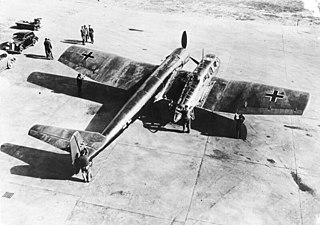
The Focke-Wulf Fw 200 Condor, also known as Kurier to the Allies, was a German all-metal four-engined monoplane originally developed by Focke-Wulf as a long-range airliner. A Japanese request for a long-range maritime patrol aircraft led to military versions that saw service with the Luftwaffe as long-range reconnaissance and anti-shipping/maritime patrol bomber aircraft. The Luftwaffe also made extensive use of the Fw 200 as a transport aircraft.

The Henschel Hs 129 was a World War II ground-attack aircraft fielded by the German Luftwaffe. The aircraft saw combat in Tunisia and on the Eastern Front.

The Arado Ar 196 was a shipboard reconnaissance low-wing monoplane aircraft built by the German firm of Arado starting in 1936. The next year it was selected as the winner of a design contest and became the standard aircraft of the Kriegsmarine throughout World War II.

The Focke-Wulf Fw 190 Würger is a German single-seat, single-engine fighter aircraft designed by Kurt Tank at Focke-Wulf in the late 1930s and widely used during World War II. Along with its well-known counterpart, the Messerschmitt Bf 109, the Fw 190 became the backbone of the Luftwaffe's Jagdwaffe. The twin-row BMW 801 radial engine that powered most operational versions enabled the Fw 190 to lift larger loads than the Bf 109, allowing its use as a day fighter, fighter-bomber, ground-attack aircraft and, to a lesser degree, night fighter.

Focke-Wulf Flugzeugbau AG was a German manufacturer of civil and military aircraft before and during World War II. Many of the company's successful fighter aircraft designs were slight modifications of the Focke-Wulf Fw 190. It is one of the predecessor companies of today's Airbus.

The Messerschmitt Bf 110, often known unofficially as the Me 110, is a twin-engine Zerstörer and fighter-bomber developed in Nazi Germany in the 1930s and used by the Luftwaffe during World War II. Hermann Göring was a proponent of the Bf 110. It was armed with two MG FF 20 mm cannon, four 7.92 mm MG 17 machine guns, and one 7.92 mm MG 15 machine gun for defence. Development work on an improved type to replace the Bf 110, the Messerschmitt Me 210 began before the war started but its teething troubles resulted in the Bf 110 soldiering on until the end of the war in various roles, with its replacements, the Me 210 and the significantly improved Me 410 Hornisse.

The Focke-Wulf Fw 187 Falke ("Falcon") was a German aircraft developed in the late 1930s. It was conceived by Kurt Tank as a twin-engine, high-performance fighter, but the Luftwaffe saw no role for the design, perceiving it as intermediate between the Messerschmitt Bf 109 and Bf 110. Later prototypes were adapted to two-seats to compete with the Bf 110 in the Zerstörer role, but only nine aircraft were built in total.

The Focke-Wulf Fw 58 Weihe ("Harrier") was a German aircraft, built to fill a request by the Luftwaffe for a multi-role aircraft, to be used as an advanced trainer for pilots, gunners and radio operators.

The Blohm & Voss BV 141 was a World War II German tactical reconnaissance aircraft. It is notable for its uncommon structural asymmetry. Although the Blohm & Voss BV 141 performed well, it was never ordered into full-scale production, for reasons that included the unavailability of the preferred engine and competition from another tactical reconnaissance aircraft, the Focke-Wulf Fw 189.

The Focke-Wulf Fw 191 was a prototype German bomber of World War II, as the Focke-Wulf firm's entry for the Bomber B advanced medium bomber design competition. Two versions were intended to be produced, a twin-engine version using the Junkers Jumo 222 engine and a four-engine variant which was to have used the smaller Daimler-Benz DB 605 engine. The project was eventually abandoned due to technical difficulties with the engines.
The Focke-Wulf Ta 153 (GH+KV) was a prototype German fighter aircraft built during World War II. It was a development of the Fw 190C, a Fw 190A with a DB 603A engine.

The Argus As 10 was a German-designed and built, air-cooled 90° cylinder bank-angle inverted V8 "low power" aircraft engine, used mainly in training aircraft such as the Arado Ar 66 and Focke-Wulf Fw 56 Stösser and other small short-range reconnaissance and communications aircraft like the Fieseler Fi 156 Storch during, and shortly after World War II. It was first built in 1928.

The Heinkel He 45 was a light bomber produced in Germany in the early 1930s, one of the first aircraft adopted by the newly formed Luftwaffe. Its appearance was that of a conventional biplane and included seating for pilot and gunner in tandem, open cockpits. Developed in parallel with the He 46, it appeared in 1931 as a general-purpose biplane and was employed mainly as a trainer, but was also used by the Luftwaffe for reconnaissance and light bombing duties. Production of this plane totalled 512 aircraft, including those built under licence by Gotha, Focke-Wulf, and BFW.

The Henschel Hs 124 was a twin-engine heavy fighter, attack aircraft and light bomber designed in Nazi Germany. After two prototypes had been built, work on the project was cancelled.
The Dornier Do 29 was a proposed zerstörer, or heavy fighter, designed by Dornier as a competitor to the Messerschmitt Bf 110.
The Focke-Wulf Fw 300 was a proposed very-long-range civil airliner, transport, reconnaissance aircraft and anti-ship aircraft, designed by Focke-Wulf in 1941 and 1942. The design was intended to replace the Focke-Wulf Fw 200 Condor.

The Focke-Wulf Fw 56 Stösser was a single-engine, parasol monoplane advanced trainer, built in the 1930s in Germany.

The Focke-Wulf Fw 62 was a reconnaissance floatplane, designed and built by Focke-Wulf for use by Nazi Germany's Kriegsmarine. Only four were built.

















